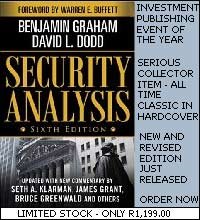This ratio is simply the market capitalisation on the day divided by its total assets minus its liabilities. It is representative of what the company were worth should it be liquidated. Why should we start with this indicator when building a stock portfolio? From page 9 of Grahams' all time 30 year classic "The Intelligent Investor" he quotes "Strangely enough, we shall suggest as one of our chief requirements that our readers limit themselves to issues selling not far above their tangible-asset value".
The book goes on to state that "The reason for this seemingly outmoded counsel is both practical and psychological. Experience has taught us that, while there are many good growth companies worth several times net assets, the buyer of such shares will be too dependant on the vagaries and fluctuations of the the stock market. By contrast, the investor in sound businesses selling at slightly above asset value can always consider themselves owners of of an interest in sound and expanding businesses, acquired at rational prices - regardless of what the stock market may say to the contrary."
But in market crashes such as the one we are currently in, the Price:Book ratio becomes even more important a selector. This is because markets tend to over-react (both on the up and on the down) and when panic ensues, prices have the tendency to go way below fair value. Graham said that stocks selected with low Price:Book ratios in a crash can form very defensive stocks, since the underlying value of the stock is far higher than what you paid for it. Over time, after one or two interims or finals, the market will quickly realise this and the stock will rise accordingly.
Just about every value investment book mentions this, but nobody has ever tested this theory on the JSE. We set out to do just that and we proudly display the results below.

Sure enough, we are presented with an astounding vilification on the JSE of Grahams sage advice. There is a remarkably clear and distinct correlation between low Price:Book ratios at the trough of a bear market, and their ability to outperform the rest of the market in the ensuing 5 years. We can look at the above graph and state that historically, Price:book ratios of less than 1 will significantly outperform those with a value greater than 1, with spectacular out performance demonstrated by issues worth less than 50% of net asset value.
NEXT UP : Book Value JSE Candidates







No comments:
Post a Comment